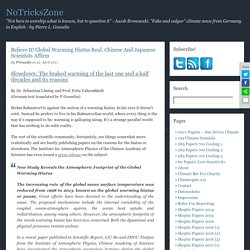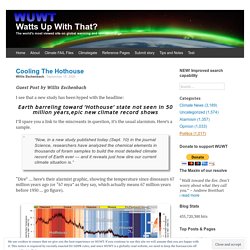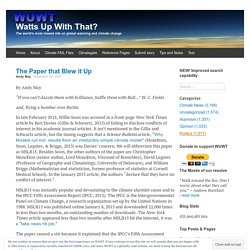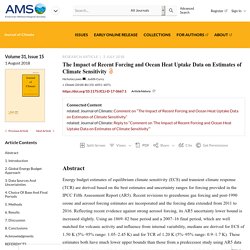

CO2 sensitivity: the polar solution. By Alan Longhurst Natural climate variability in the polar regions.

If our planet had been designed with comparative high-latitude studies in mind, it couldn’t have been better arranged than it is. The 700N parallel encloses extensive continental regions that were once ecologically rich forest and grassland but now support agriculture, stock raising and urbanisation. A remnant of the north polar ice-cap of past epochs lies beside a small central ocean having extensive continental shelves; these are wide open to the wind-driven passage of sun-warmed Gulf Stream and North Atlantic water through the Norwegian Sea and to a less important influx of cooler Pacific water through the Bering Straits. But the 70oS parallel passes closely around an ice-capped continent half the size of Africa that is vegetated in only a few places, mostly by moss and lichens, and is inhabited solely by marine mammals, birds and scientists.
The climate of the Arctic and its small central ocean. : "Not here to worship what is known, but to question it" – Jacob Bronowski. Climate and energy news from Germany in English – by Pierre L. Gosselin. It’s time for wind energy proponents to admit that their well-intended idea of wind energy has in fact had disastrous ecological consequences.

No technological development has ever so negatively impacted the environment and landscape like wind turbines have. Not only do they blight the scenic landscape and make people living near them ill, they are a serious killer of avian wildlife, as made evident by a recent German ZDF Terra X documentary shows (starts at 34:15 min). Hat-tip: Alessandra E. Wind turbines in fact do pose serious threat to endangered birds. Image cropped from ZDF Terra X. One of Germany’s most protected bird species is the endangered red kite hawk.
The segment focusses on the southwest German state of Baden Württemberg, where its Green state minister is attempting to force through the construction of thousands of turbines on the regions idyllic landscape in a bid to go green. Ignorance, corruption and criminal sabotage Need 12 sq. km of space, and not 3 sq km. Cooling The Hothouse. Guest Post by Willis Eschenbach I see that a new study has been hyped with the headline: I’ll spare you a link to the miscreants in question, it’s the usual alarmism.

Here’s a sample. “Now, in a new study published today (Sept. 10) in the journal Science, researchers have analyzed the chemical elements in thousands of foram samples to build the most detailed climate record of Earth ever — and it reveals just how dire our current climate situation is.” “Dire” … here’s their alarmist graphic, showing the temperature since dinosaurs 67 million years ago (or “67 mya” as they say, which actually means 67 million years before 1950 … go figure). Study suggests no more CO2 warming. Precision research by physicists William Happer and William van Wijngaarden has determined that the present levels of atmospheric carbon dioxide and water vapor are almost completely saturated.

In radiation physics the technical term “saturated” implies that adding more molecules will not cause more warming. In plain language this means that from now on our emissions from burning fossil fuels could have little or no further impact on global warming. There would be no climate emergency. No threat at all. The Paper that Blew it Up. By Andy May “If you can’t dazzle them with brilliance, baffle them with Bull…” W.

C. Fields and, flying a bomber over Berlin. In late February 2015, Willie Soon was accused in a front-page New York Times article by Kert Davies (Gillis & Schwartz, 2015) of failing to disclose conflicts of interest in his academic journal articles. MSLB15 was instantly popular and devastating to the climate alarmist cause and to the IPCC Fifth Assessment Report (IPCC, 2013). Physicists: A CO2 Rise To 800 ppm Causes ‘Hypothetical’ 10°C Upper Atmosphere Cooling, 1.4°C Surface Warming. By Kenneth Richard on 26.

November 2020 A new analysis by Drs. Wijngaarden and Happer (2020) suggests the “self-interference” saturation of all greenhouse gases in the current atmosphere substantially reduces their climate forcing power. At the current concentrations, the forcing power for greenhouse gases like CO2 (~400 ppm) and CH4 (1.8 ppm) are already saturated.
Therefore, even doubling the current greenhouse gas concentrations may only increase their forcings “by a few percent” in the parts of the atmosphere where there are no clouds. A New Experiment Finds Just A 1.3°C Temperature Differential For Contained Air With 0.05% Versus 100% CO2. A new balloon experiment (inadvertently) demonstrates just how weak and inconsequential CO2’s warming effect is.

Levendis et al. (2020) tried using an experiment with air-filled (99% nitrogen and oxygen) versus CO2-filled (100% CO2) balloons to demonstrate a consequential warming effect for CO2. But their study may have demonstrated the opposite. In the experiment a heat source was applied and then removed (shut off) to 3 different-sized balloons with 100% (1,000,000 ppm) CO2 in them. They compared the rate of cooling for these CO2-filled balloons to the cooling rate for a balloon filled with regular room air that has ~790,000 ppm nitrogen (N2), ~210,000 ppm oxygen (O2), ~9,000 ppm Argon (Ar), and ~500 ppm CO2. The results revealed the temperature inside the 1,000,000 ppm CO2 balloons cooled just ~1.3°C (0.5 to 2.0°C) more slowly after 6½ minutes than the balloon with ambient air with ~500 ppm CO2.
Former WMO Official: CO2 “Insignificant For Balance Of Energy”, “Completely Unnecessary” To Reduce CO2. CO2 has little impact on climate, important for life, says former UN official.

By Albert Köhler MSc. (Translation, editing, subheadings by P Gosselin) With this manuscript I would like to deal with the CO2 topic, which currently seems to be so extremely important for media and politics, solely according to the precepts of free and real scientific argumentation, but also driven by my conscience as a physicist who has been active in this field since about 1960. I am compelled by moral obligation for my fellow human beings, to whom one would expect financial sacrifices in the trillions of dollars and very significant losses in quality of life in the following years and decades, although CO2 has practically nothing to do with climate change.
Water vapor 1000 times stronger. (2) How sensitive is the atmosphere? Crisis looms in alarmist climate science. Climate science is dominated by alarmists addicted to the idea that increasing carbon dioxide will cause dangerous global warming.

How much warming is thus the central scientific question. The Impact of Recent Forcing and Ocean Heat Uptake Data on Estimates of Climate Sensitivity. There has been considerable scientific investigation of the magnitude of the warming of Earth’s climate from changes in atmospheric carbon dioxide (CO2) concentration.

Two standard metrics summarize the sensitivity of global surface temperature to an externally imposed radiative forcing. Equilibrium climate sensitivity (ECS) represents the equilibrium change in surface temperature to a doubling of atmospheric CO2 concentration. Transient climate response (TCR), a shorter-term measure over 70 years, represents warming at the time CO2 concentration has doubled when it is increased by 1% yr−1.
For over 30 years, climate scientists have presented a likely range for ECS that has hardly changed. The ECS range 1.5–4.5 K in 1979 (Charney et al. 1979) is unchanged in the 2013 Fifth Assessment Report (AR5) from the IPCC (IPCC 2013). Emergent constraints on TCR and ECS from historical warming in CMIP5 and CMIP6 models. Reposted from Dr. Judith Curry’s Climate Etc. Posted on August 19, 2020 by niclewis By Nic Lewis This is a brief comment on a new paper[i] by a mathematician in the Exeter Climate Systems group, Femke Nijsse, and two better known colleagues, Peter Cox and Mark Williamson. I note that Earth Systems Dynamics published the paper despite one of the two peer reviewers recommending against acceptance without further major revisions.
New paper suggests historical period estimates of climate sensitivity are not biased low by unusual variability in sea surface temperature patterns. Reposted from Dr. Judith Curry’s Climate Etc. Posted on August 24, 2020 by niclewis | By Nic Lewis An important new paper by Thorsten Mauritsen, Associate Professor at Stockholm University[i] and myself has just been accepted for publication (Lewis and Mauritsen 2020)[ii].
An estimate of Climate Sensitivity. Reposted from edmhdotme Assuming the logarithmic diminution premise to be appropriate, this diagram indicates: when plants evolved, atmospheric CO2 levels were very much higher than at present (~10-20 times) and no runaway Global warming occurred. those high levels of CO2 atmosphere have progressively been reduced, with CO2 both being absorbed by the Oceans to be sequestered as limestone by Ocean life or converted into fossil fuelsonly some 20,000 years ago, in the depths of the last ice age, Life on Earth came very close to total annihilation when atmospheric CO2 concentration fell to 180 ppmv, only ~15% above its terminal value:
Study: High End Model Climate Sensitivities Not Supported by Paleo Evidence. Guest essay by Eric Worrall University of Michigan researchers have done the unthinkable, and checked climate model predictions against available paleo-climate data to see if the predictions are plausible. “People underestimate the power of models. Observational evidence is not very useful” – attributed to John Mitchell, UK MET Most fields of science don’t accept a model unless it has been rigorously validated against available data, but climate science is different; the modelling process itself frequently seems to be accepted as evidence that the climate model is correct, a circular chain of reasoning which leads to positions which outside of climate science would be considered absurd.
Reproduction of UN IPCC's climate sensitivity shows mere 0.6 °C not 1.8 °C. Published on March 3, 2020 Written by Dr Antero Ollila Even if there is such a thing as ‘climate sensitivity’ to carbon dioxide (CO2) we can see, even by the UN IPCC’s own figures, it is less than widely claimed. Playing ‘devil’s advocate’ Dr Antero Ollila crunches those official numbers and reveals a very unremarkable, non-threatening statistic.
Dr Ollila of Aalto University, Helsinki, Finland, explains as follows: The highest ranked scientific journal Nature published on the 28th of July 2016 an article based on the survey for 1,576 researchers. New Experimental Evidence: The Atmosphere Cools As More CO2 Is Added…High CO2 ‘May Enhance Net Heat Loss’ An observational study analyzing the effects of 300, 480, 3200, 7500, and 16,900 ppm CO2 on atmospheric (and soil) temperatures has determined “temperatures of atmospheric air in mesocosms [controlled outdoor experiments] with substantially higher CO2 concentration (ranging from 3200 ppm to 16900 ppm) were lower than that with the lower CO2 concentration (480 ppm)”.
Image Source: Zhang et al., 2020. On Climate Sensitivity. Physics Professor: CO2’s 0.5°C Impact After Rising To 700 ppm Is So Negligible It’s ‘Effectively Unmeasurable’ Study Recalculates New Greenhouse Effect Values And Sharply Minimizes CO2’s Contribution And Climate Sensitivity. Light Bulbs Disprove Global Warming. Dr. Peter Ward explains at The Hill Greenhouse gases simply do not absorb enough heat to warm Earth Excerpts in italics with my bolds. Climate sensitivity in light of the latest energy imbalance evidence.
Study: No Discernible Link From CO2 Forcing To Climate For 97% Of The Last 425 Million Years. For CO2 to be considered a driver of Earth’s temperatures, changes in CO2 that uni-directionally correlate with temperatures should not be an exceptional occurrence. Yet a causal link from CO2 radiative forcing to temperature changes could hypothetically be inferred for just 2.6% of the last 425 million years. A detailed analysis (Davis, 2017) of temperature and CO2 proxies over the Phanerozoic Eon by environmenalist Dr. W. Jackson Davis finds that for 77.9% of the record there was a non-discernible correlation between CO2 and temperature. A Decided Lack Of Equilibrium. Scientists Document A DECLINE In Overall Greenhouse Effect Forcing From 1985-2014.
8000 Years Of Zero Correlation Between CO2 And Temperature, GISP 2 Ice Core Shows – Opposite Is True! By P Gosselin on 20. The List Grows – Now 100+ Scientific Papers Assert CO2 Has A Minuscule Effect On The Climate. Comment by Cowtan & Jacobs on Lewis & Curry 2018 and Reply: Part 1. From Dr. Comment by Cowtan & Jacobs on Lewis & Curry 2018 and Reply: Part 2. Scientists: CO2 Causes Cooling When Not Causing Warming And It’s A ‘Weak’ To ‘Negligible’ Climate Factor. Gregory et al 2019: Unsound claims about bias in climate feedback and climate sensitivity estimation.
H2O Reduces CO2 Climate Sensitivity. The Charney Report Revisited. What’s the worst case? Climate sensitivity. Improving Estimates of Long-Term Climate Sensitivity. Climate sensitivity. What’s the worst case? Climate sensitivity. Climate sensitivity calculator app. Improving Estimates of Long-Term Climate Sensitivity. Nic Lewis disputes necessity for zero emissions in 2050. German Scientists Back Findings By Gebbie et al 2019, Believe Climate CO2 Sensitivity Even “Likely To Be Lower” Than 1.3°C.
Game over. The “Climate Sensitivity” folly « Okulær. Climate sensitivity to cumulative carbon emissions. The List Grows – Now 85 Scientific Papers Assert CO2 Has A Minuscule Effect On The Climate. 60 Papers: Low Sensitivity. Warming patterns are unlikely to explain low historical estimates of climate sensitivity. IPCC Overestimates Climate Sensitivity: Study. How low can ECS go? Ross McKitrick: All those warming-climate predictions suddenly have a big, new problem. Important new study from AWI: Cooling discovered in Antarctica, enabled by Carbon Dioxide.
Why the new Otto et al climate sensitivity paper is important – it’s a sea change for some IPCC authors. Climate Sensitivity: A Simple Inverse Model. On the Reproducibility of the IPCC’s climate sensitivity. It shouldn’t take hundreds of years to estimate climate sensitivity. Atomic Physicist: Human CO2 Emissions Have An Equilibrium Climate Sensitivity Of A ‘Not Important’ 0.02 K. New data imply lower climate sensitivity, thus slower global warming. Impact of recent forcing and ocean heat uptake data on estimates of climate sensitivity. Why Dessler et al.’s critique of energy-budget climate sensitivity estimation is mistaken. Emergent constraints on climate sensitivity: Part I. Emergent constraints on climate sensitivity: Part II. Emergent constraints on climate sensitivity in global models. Part III. What can decadal variability tell us about climate feedbacks and sensitivity? Claim: Climate sensitivity narrowed to 2.8°C. Ideal Gases. “Seismic Shift” In Climate Science… IPCC CO2-Induced Warming Estimate “Far Too High”…”In A Free Fall”
New Atmospheric Sciences Textbook: Climate Sensitivity Just 0.4°C For CO2 Doubling. On the Reproducibility of the IPCC’s climate sensitivity. Japanese Scientist Reiterates That CO2 Climate Sensitivity Is Overstated, “Theoretically Meaningless” Recent CO2 Climate Sensitivity Estimates Continue Trending Towards Zero. 2 New Papers: Models ‘Severely Flawed’, Temp Changes Largely Natural, CO2 Influence ‘Half’ Of IPCC Claims. U of Canberra Expert: Doubling Atmospheric CO2 Would Increase “Heating By Less Than 0.01°C”